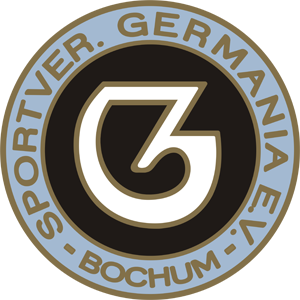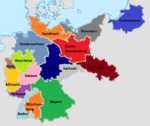
The Oberliga West was the highest level of the German football league system in the west of Germany from 1947 until the formation of the Bundesliga in 1963. It covered the state of North Rhine-Westphalia, the most populous state of Germany.

The Gauliga Bayern was the highest association football league in the German state of Bavaria from 1933 to 1945. Shortly after the formation of the league, the Nazis reorganised the administrative regions in Germany, and the five GaueBayreuth, Munich-Upper Bavaria, Swabia, Main Franconia and Franconiade facto replaced the state of Bavaria which remained only as a symbolic region.

The Gauliga Baden was the highest football league in the German state of Baden from 1933 to 1945. Shortly after the formation of the league, the Nazis reorganised the administrative regions in Germany, and the Gau Baden replaced the state Baden.

The Gauliga Hessen was the highest football league in the German state of Hesse and the Prussian province of Hesse-Nassau from 1933 to 1945. From 1941, it was renamed Gauliga Kurhessen. Shortly after the formation of the league, the Nazis reorganised the administrative regions in Germany, and the GauElectoral Hesse replaced the Prussian province and the Peoples State.

The Gauliga Ostpreußen was the highest football league in the Prussian province of East Prussia and the Free City of Danzig from 1933 to 1945. Shortly after the formation of the league, the Nazis reorganised the administrative regions in Germany, and the GauEast Prussia the Prussian province. Danzig however did not become part of this Gau, being integrated in the Gau Danzig-West Prussia in 1939 instead.

The Gauliga Danzig-Westpreußen was the highest football league in the former Reichsgau Danzig-West Prussia, a Nazi administrative unit established partly from German and partly from annexed territory.

The Gauliga Pommern was the highest football league in the Prussian province of Pomerania (German:Pommern) from 1933 to 1945. Shortly after the formation of the league, the Nazis reorganised the administrative regions in Germany, and the GauPomerania replaced the province of Pomerania.

The Gauliga Mitte was the highest football league in the Prussian province of Saxony and the German states of Thuringia and Anhalt from 1933 to 1945, all located in the center (German:Mitte) of Germany. Shortly after the formation of the league, the Nazis reorganised the administrative regions in Germany, and the GaueThuringia, Magdeburg-Anhalt and Halle-Merseburg replaced the states and Prussian province.

The Gauliga Niederrhein was the highest football league in the northern part of the Prussian Rhine Province from 1933 to 1945. Shortly after the formation of the league, the Nazis reorganised the administrative regions in Germany, and the GaueEssen and Düsseldorf replaced the Prussian province in the Lower Rhein region.

The Gauliga Mittelrhein was the highest football league in the central and southern part of the Prussian Rhine Province from 1933 to 1945. Shortly after the formation of the league, the Nazis reorganised the administrative regions in Germany, and the GaueKöln-Aachen and Moselland replaced the Prussian province in the Middle Rhine region.

The Gauliga Niedersachsen was the highest football league in the Prussian Province of Hanover and the German states of Bremen, Brunswick, Schaumburg-Lippe and Oldenburg from 1933 to 1945. Shortly after the formation of the league, the Nazis reorganised the administrative regions in Germany, and the GaueSüdhannover-Braunschweig, Ost-Hannover and Weser-Ems de facto replaced the Prussian province and the German states in the region of Lower Saxony (German:Niedersachsen), although de jure the old states continued to exist.

The Gauliga Schlesien was the highest football league in the region of Silesia (German:Schlesien), which consisted of the Prussian provinces of Lower Silesia and Upper Silesia from 1933 to 1945. Shortly after the formation of the league, the Nazis reorganised the administrative regions in Germany, and the Gau Silesia, later subdivided into Gau Upper Silesia and Gau Lower Silesia, replaced the Prussian provinces.

Sportverein Germania Vorwärts Bochum 1906 was a German association football club from the city of Bochum, North Rhine-Westphalia.

The 1934–35 Gauliga was the second season of the Gauliga, the first tier of the football league system in Germany from 1933 to 1945.

The 1935–36 Gauliga was the third season of the Gauliga, the first tier of the football league system in Germany from 1933 to 1945.

The 1936–37 Gauliga was the fourth season of the Gauliga, the first tier of the football league system in Germany from 1933 to 1945.

The 1937–38 Gauliga was the fifth season of the Gauliga, the first tier of the football league system in Germany from 1933 to 1945.

The 1938–39 Gauliga was the sixth season of the Gauliga, the first tier of the football league system in Germany from 1933 to 1945. It was the last completed season before the Second World War.

The 1941–42 Gauliga was the ninth season of the Gauliga, the first tier of the football league system in Germany from 1933 to 1945. It was the third season of the league held during the Second World War.

The 1943–44 Gauliga was the eleventh season of the Gauliga, the first tier of the football league system in Germany from 1933 to 1945. It was the fifth season of the league held during the Second World War and the last completed one.




